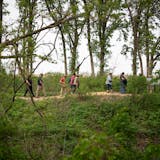WAPPINGERS FALLS, N.Y. — As the World War II bomber Heaven Can Wait was hit by enemy fire off the Pacific island of New Guinea on March 11, 1944, the co-pilot managed a final salute to flyers in an adjacent plane before crashing into the water.
All 11 men aboard were killed. Their remains, deep below the vast sea, were designated as non-recoverable.
Yet four crew members' remains are beginning to return to their hometowns after a remarkable investigation by family members and a recovery mission involving elite Navy divers who descended 200 feet (61 meters) in a pressurized bell to reach the sea floor.
Staff Sgt. Eugene Darrigan, the radio operator, was buried with military honors and community support on Saturday in his hometown of Wappingers Falls, New York, more than eight decades after leaving behind his wife and baby son.
The bombardier, 2nd Lt. Thomas Kelly, was to be buried Monday in Livermore, California, where he grew up in a ranching family. The remains of the pilot, 1st Lt. Herbert Tennyson, and navigator, 2nd Lt. Donald Sheppick, will be interred in the coming months.
The ceremonies are happening 12 years after one of Kelly's relatives, Scott Althaus, set out to solve the mystery of where exactly the plane went down.
''I'm just so grateful,'' he told The Associated Press. ''It's been an impossible journey — just should never have been able to get to this day. And here we are, 81 years later.''
March 11, 1944: Bomber down
![Three weeks ago, Octavio Rodriguez switched from making transmission parts to casting parts for hospital bed brake assemblies at Twin City Die Castings. ] GLEN STUBBE • glen.stubbe@startribune.com Thursday, April 9, 2020 How employee-owned Twin City Die Casting, which just laid off 40 production workers of its 250 employees in what was supposed to be a good year, is trying to accelerate its pivot to growing medical parts business for ventilators, hospital beds, etc as it copes with instan](https://arc.stimg.co/startribunemedia/WNZYKGTZ5IYMUCO3KI5TR3N7WI.jpg?&w=80&ar=1:1&fit=crop)
djoles@startribune.com As boaters flock to Minnesota lakes and rivers this holiday weekend for the unofficial kick-off to the boating season, they'll face more inspections in and out of the water as local cities and counties ramp up their work to stop the spread of invasive species. Across the metro, more boat accesses will be staffed by watercraft inspectors thanks to $10 million funneled to county government programs this year, up from $4.5 million the state allocated last year. ORG XMIT: MIN1505222156290209 ORG XMIT: MIN1506021218440580](https://arc.stimg.co/startribunemedia/34QSKO44B2XKVNUZCO5SLJQSLY.jpg?&w=80&ar=1:1&fit=crop)

